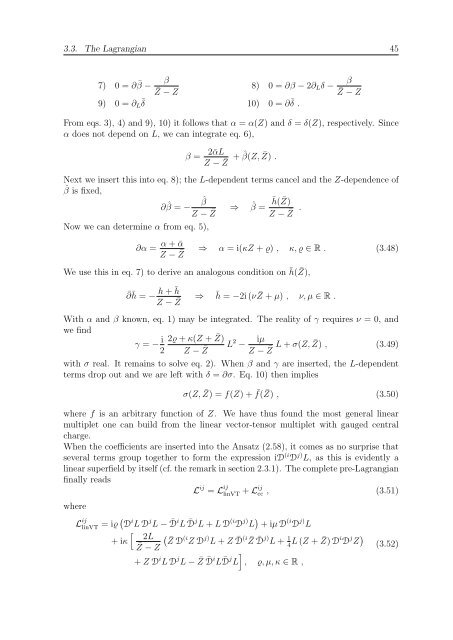N=2 Supersymmetric Gauge Theories with Nonpolynomial Interactions
N=2 Supersymmetric Gauge Theories with Nonpolynomial Interactions
N=2 Supersymmetric Gauge Theories with Nonpolynomial Interactions
Create successful ePaper yourself
Turn your PDF publications into a flip-book with our unique Google optimized e-Paper software.
3.3. The Lagrangian 45<br />
7) 0 = ∂ ¯ β − β<br />
¯Z − Z<br />
9) 0 = ∂L ¯ δ 10) 0 = ∂ ¯ δ .<br />
8) 0 = ∂β − 2∂Lδ − β<br />
¯Z − Z<br />
From eqs. 3), 4) and 9), 10) it follows that α = α(Z) and δ = δ(Z), respectively. Since<br />
α does not depend on L, we can integrate eq. 6),<br />
β = 2¯αL<br />
Z − ¯ Z + ˆ β(Z, ¯ Z) .<br />
Next we insert this into eq. 8); the L-dependent terms cancel and the Z-dependence of<br />
ˆβ is fixed,<br />
∂ ˆ β = − ˆ β<br />
Z − ¯ Z ⇒ ˆ β = ¯ h( ¯ Z)<br />
Z − ¯ Z .<br />
Now we can determine α from eq. 5),<br />
∂α =<br />
α + ¯α<br />
Z − ¯ Z<br />
⇒ α = i(κZ + ϱ) , κ, ϱ ∈ R . (3.48)<br />
We use this in eq. 7) to derive an analogous condition on ¯ h( ¯ Z),<br />
¯∂ ¯ h = − h + ¯ h<br />
Z − ¯ Z ⇒ ¯ h = −2i (ν ¯ Z + µ) , ν, µ ∈ R .<br />
With α and β known, eq. 1) may be integrated. The reality of γ requires ν = 0, and<br />
we find<br />
γ = − i 2ϱ + κ(Z +<br />
2<br />
¯ Z)<br />
Z − ¯ L<br />
Z<br />
2 − iµ<br />
Z − ¯ Z L + σ(Z, ¯ Z) , (3.49)<br />
<strong>with</strong> σ real. It remains to solve eq. 2). When β and γ are inserted, the L-dependent<br />
terms drop out and we are left <strong>with</strong> δ = ∂σ. Eq. 10) then implies<br />
σ(Z, ¯ Z) = f(Z) + ¯ f( ¯ Z) , (3.50)<br />
where f is an arbitrary function of Z. We have thus found the most general linear<br />
multiplet one can build from the linear vector-tensor multiplet <strong>with</strong> gauged central<br />
charge.<br />
When the coefficients are inserted into the Ansatz (2.58), it comes as no surprise that<br />
several terms group together to form the expression iD (i D j) L, as this is evidently a<br />
linear superfield by itself (cf. the remark in section 2.3.1). The complete pre-Lagrangian<br />
finally reads<br />
where<br />
L ij<br />
L ij = L ij<br />
linVT + Lij cc , (3.51)<br />
linVT = iϱ D i L D j L − ¯ D i L ¯ D j L + L D (i D j) L + iµ D (i D j) L<br />
<br />
2L <br />
+ iκ ¯Z (i j)<br />
¯Z<br />
D Z D L + Z ¯ (i<br />
D Z¯ ¯ j) 1 D L + 4 − Z<br />
L (Z + ¯ Z) D i D j Z <br />
+ Z D i L D j L − ¯ Z ¯ D i L ¯ D j <br />
L , ϱ, µ, κ ∈ R ,<br />
(3.52)

















